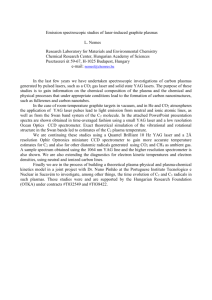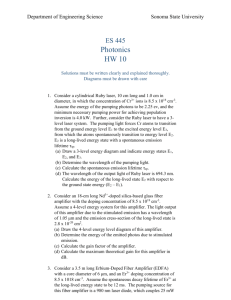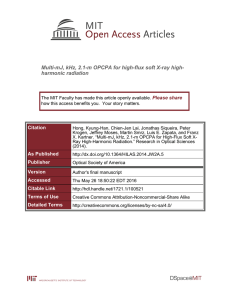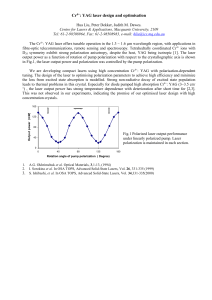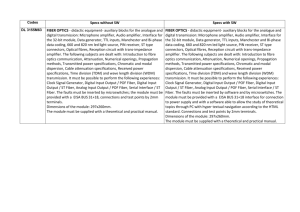High-average-power cryogenically-cooled picosecond Yb:YAG amplifier seeded by a fiber CPA system
advertisement
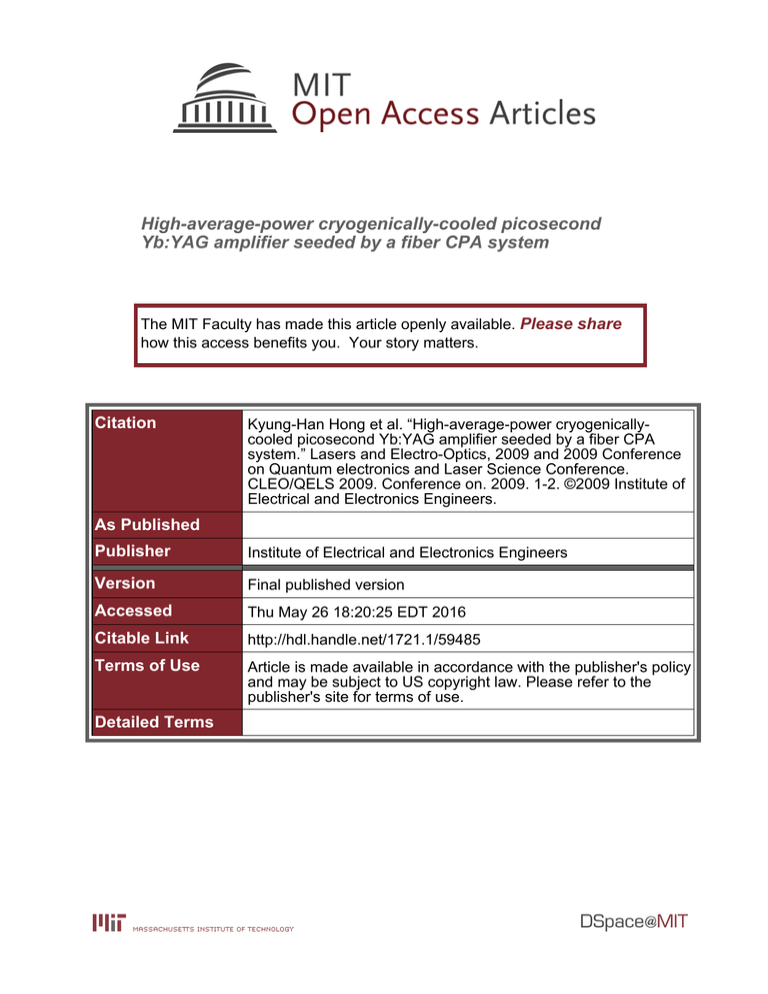
High-average-power cryogenically-cooled picosecond Yb:YAG amplifier seeded by a fiber CPA system The MIT Faculty has made this article openly available. Please share how this access benefits you. Your story matters. Citation Kyung-Han Hong et al. “High-average-power cryogenicallycooled picosecond Yb:YAG amplifier seeded by a fiber CPA system.” Lasers and Electro-Optics, 2009 and 2009 Conference on Quantum electronics and Laser Science Conference. CLEO/QELS 2009. Conference on. 2009. 1-2. ©2009 Institute of Electrical and Electronics Engineers. As Published Publisher Institute of Electrical and Electronics Engineers Version Final published version Accessed Thu May 26 18:20:25 EDT 2016 Citable Link http://hdl.handle.net/1721.1/59485 Terms of Use Article is made available in accordance with the publisher's policy and may be subject to US copyright law. Please refer to the publisher's site for terms of use. Detailed Terms a478_1.pdf CThJ4.pdf CThJ4.pdf © 2009 OSA/CLEO/IQEC 2009 High-average-power cryogenically-cooled picosecond Yb:YAG amplifier seeded by a fiber CPA system Kyung-Han Hong,1,* Juliet Gopinath,2 Aleem Siddiqui,1 Jeffrey Moses,1 Chien-Jen Lai,1 John Hybl,2 and Tso Yee Fan2 1 Department of Electrical Engineering and Computer Science and Research Laboratory of Electronics, Massachusetts Institute of Technology (MIT), Cambridge, Massachusetts 02139, USA 2 MIT Lincoln Lab, Lexington, Massachusetts 02420, USA *Email: kyunghan@mit.edu Abstract: We report on a 300-W-level picosecond laser based on a cryogenically-cooled Yb:YAG amplifier seeded by a fiber CPA system. High-average-power picosecond second harmonic generation is also presented. ‘2009 Optical Society of America OCIS codes: (140.3280) Laser amplifiers, (140.3615) Lasers, ytterbium, (060.2320) Fiber optics amplifiers and oscillators 1. Introduction Recently, high-power picosecond lasers have become of interest as a pump source for optical parametric chirped pulse amplification (OPCPA) [1] due to several distinctive advantages over chirped-pulse amplification (CPA). However, high-quality OPCPA pump sources are needed because parametric amplification with high efficiency and good beam quality occurs only with a good spatio-temporal overlap between the pump and seed beams. The development of a high-average-power picosecond pump source that can be synchronized with seed beams of either high or low repetition rate is one of the most important challenges for future OPCPA technologies and their applications. Besides the OPCPA applications, the high-power picosecond lasers can be widely used for nonlinear frequency conversion to any desired wavelength range. Over the past several years, high-power high-repetition-rate picosecond laser technologies have been developed both on the basis of fiber and bulk amplifiers. Using fiber amplifiers, 10-ps pulses at 47 MHz to 97 W and 20-ps pulses at 1 GHz to 321 W have been demonstrated [2,3]. In the latter case, however, for >100-W average power the pulses showed spectral broadening due to self-phase modulation (SPM). Using bulk amplifiers, several solid-state picosecond laser systems, based on Nd:YAG, thin-disk Yb:YAG, and Nd:YVO4, with average powers of up to 111 W have been demonstrated [4]. Bulk amplifiers have advantages in terms of peak- and average-power scaling and polarization maintenance compared with fiber amplifiers due to the large cross-section, high doping-rate, and short length of gain materials. Recently, a cryogenically-cooled Yb:YAG laser has proven to be a good candidate for average-power scaling because of its good thermo-optic properties, small quantum defect, and low saturation fluence. At cryogenic temperatures, Yb:YAG has an emission bandwidth of 1.5 nm, suitable for picosecond-pulse amplification. A high-power cw Yb:YAG laser with output power up to >450 W [5] and a picosecond amplifier at tens of kHz with 24 W [6] have been demonstrated. In this paper, we report on the direct amplification of 5.5-ps pulses with a cryogenically-cooled Yb:YAG amplifier at a repetition rate of 78 MHz with 287 W of average output power [7]. As a picosecond seed source for the Yb:YAG amplifier, a 7.1-W picosecond fiber CPA system based on chirped volume Bragg gratings (CVBGs) was developed. The high-average-power picosecond second harmonic generation (SHG) using a LBO crystal also will be presented. This IR or green picosecond laser source is suitable for pumping high-average-power OPCPA systems. 2. Experimental setup and results The optical layout of the fiber CPA chain and the high-power cryogenically-cooled Yb:YAG amplifier is illustrated in Fig. 1. We used a femtosecond Yb-doped fiber laser as a master oscillator at 78 MHz. The use of a femtosecond laser as a seed source for a picosecond amplifier allows wavelength matching to various 1-µm amplifier media, such as Ti:sapphire, for OPCPA. The narrow 1029-nm portion was selectively amplified in the fiber CPA chain because several watts of seed power within 1.5-nm spectral bandwidth are necessary for efficient amplification in the Yb:YAG amplifier. The two-stage Yb-doped fiber amplifier shown in Fig. 1(a) is comprised of a single-mode preamplifier and a 10-W polarization-maintaining amplifier. Direct amplification of the seed pulses after simple spectral filtering leads to strong SPM and limited the amplification to ~0.3 W. To boost the average power without SPM, we employed a CPA technique based on CVBGs that enables the stretching of a narrowband ps pulse to >100 ps and re-compression to the original pulse duration at high efficiency. The >100-ps pulse stretched from a CVBG in Fig. 1(a) was amplified to 10.5 W from the two-stage fiber amplifier chain. The output pulses were compressed to 5 ps with a bandwidth of 0.4 nm. The amplified spectrum is free of SPM-induced spectral broadening down to -50 dB, 978-1-55752-869-8/09/$25.00 ©2009 IEEE a478_1.pdf CThJ4.pdf CThJ4.pdf © 2009 OSA/CLEO/IQEC 2009 only limited by the measurement. The compressed power was 7.1 W at maximum output power from the amplifier with a compression efficiency of 68%. This fiber CPA system generated narrow-bandwidth ps pulses with enough average power and good beam quality to seed the cryogenic Yb:YAG amplifier. (a) CVBG stretcher 30-mW Yb-fiber preamplifier (b) λ/4 λ/2 370 ps λ/4 PBS Yb-fiber oscillator (78 MHz) CVBG compressor LN2 Dewar L1 L2 DM Yb:YAG crystals DM L2 Fiber-coupled pump laser L1 F1029 FI λ/2 CM L3 λ/4 PBS Telescope 10-W Yb-fiber amplifier λ/4 TFP 287 W, 5.5 ps, 3.7 μJ@78 MHz Fig. 1 Optical layout of a high-average-power picosecond laser system: (a) 6-W fiber CPA chain based on CVBG, (b) 287-W cryogenically-cooled double-pass Yb:YAG amplifier. PBS, polarization beamsplitter; λ/4, quarter waveplate; λ/2, half waveplate; F1029, band-pass filter at 1029 nm; FI, Faraday isolator; FR, Faraday rotator; CVBG, chirped volume Bragg grating; TFP, thin-film polarizer; L1L3, lens; CM, concave mirror; DM, dichroic mirror. λ/2 FR 4.5 ps λ/2 PBS The amplified picosecond pulse train was delivered to the cryogenically-cooled two-pass Yb:YAG amplifier pumped by 700 W of power from two fiber-coupled laser diodes, as illustrated in Fig. 1(b). The 940-nm pump beams, delivered by two 0.4-mm-diameter multimode fibers, are focused at each crystal to a diameter of ~1.6 mm. Two 23mm-long Yb:YAG crystals have a doping concentration of 2-at.%, and their surfaces are anti-reflection coated and have a normal-incidence cut with a 1-mm undoped YAG endcap on each side of the pump beam entrance. The pump beams are focused to the crystals through the dichroic mirrors while the crystals are cooled by liquid nitrogen. The double-pass geometry was implemented using two thin-film polarizers and a quarter waveplate. The seed-beam diameter was adjusted to <1.5 mm at the crystal for both passes using a lens (L3) and a concave mirror (CM) located at a confocal position to L3 in Fig. 1(b). We obtained an average output power as high as 287 W with 700 W of pump power, corresponding to an optical-to-optical efficiency of 41%. The calculated output power versus pump power, assuming a Gaussian beam profile and taking into account temperature effects and loss due to amplified spontaneous emission, shows good agreement to the measured output power. The amplified spectrum with a bandwidth of 0.3 nm did not show any indication of SPM. The amplified pulse duration was 5.5 ps (FWHM) from the autocorrelation trace, which is 1.4 times the transform-limited pulse duration of 4.0 ps. Considering the estimated B-integral value of only 5.1x10-3 rad at the Yb:YAG crystals, the average power can be scaled to >10 kW without SPM. Spatial measurements showed a good near-field profile in the horizontal and vertical directions. The far-field image reveals an elliptical focused spot due to the spatial chirp induced by the CVBG, resulting in the M2 value in the horizontal direction as high as 2.75. The M2 value in the vertical direction was only 1.15. The second harmonic generation experiment is in progress to obtain >100-W picosecond green pulses. A calculation shows that >80% conversion efficiency can be obtained using an 8-mm-long type I LBO crystal with a focal diameter of ~0.1 mm, assuming perfect phase matching. Both critical and noncritical phase matching schemes are being studied for the efficient generation of 515-nm pulses with an excellent spatial beam quality. This work was supported by the AFOSR (FA9550-06-1-0468 and FA9550-07-1-0014) through the DARPA HRS program and MIT Lincoln Laboratory. The Lincoln Laboratory portion of the work was sponsored by the DARPA under Air Force contract FA8721-05-C-0002. Opinions, interpretations, conclusions, and recommendations are those of the authors and are not necessarily endorsed by the United States Government. 3. References [1] A. Dubietis, R. Butkus, and A. Piskarskas, IEEE JST QE 12, 163 (2006). [2] J. Limpert N. Deguil-Robin, I. Manek-Hönninger, F. Salin, T. Schreiber, A. Liem, F. Roser, H. Zellmer, A. Tünnermann, A. Courjaud, C. Hönninger, and E. Mottay, Opt. Lett. 30, 714 (2005). [3] P. Dupriez, A. Piper, A. Malinowski, J. K. Sahu, M. Ibsen, B. C. Thomsen, Y. Jeong, L. M. B. Hickey, and M. N. Zervas, IEEE Photon. Tech. Lett. 18, 1013 (2006). [4] L. McDonagh, R. Wallenstein, and A. Nebel, Opt. Lett. 32, 1259 (2007). [5] T. Y. Fan, D. J. Ripin, R. L. Aggarwal, J. R. Ochoa, B. Chann, M. Tilleman, and J. Spitzberg, IEEE JST-QE 13, 448 (2007). [6] S. Tokita, J. Kawanaka, Y. Izawa, M. Fujita, and T. Kawashima, Opt. Express 15, 3955 (2007). [7] K.-H. Hong, A. Siddiqui, J. Moses, J. Gopinath, J. Hybl, F. Ö. Ilday, T. Y. Fan, and F. X. Kärtner, Opt. Lett., 33, 2473 (2008).
